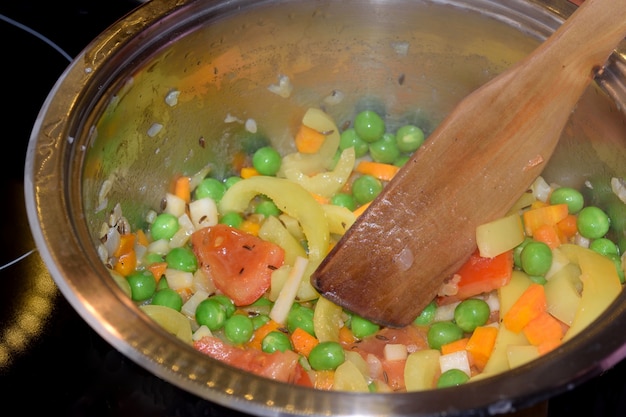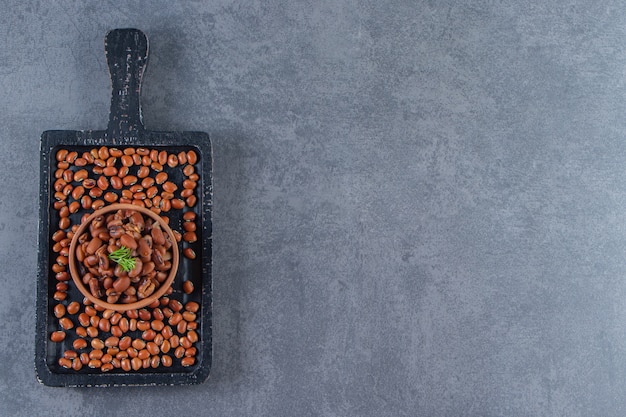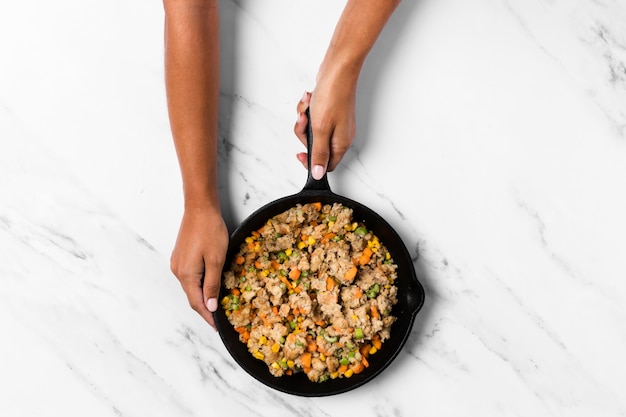Lentils, those little nutritional powerhouses, are a constant in my kitchen. They’re versatile, delicious, and incredibly budget-friendly. But let's face it, figuring out how long to cook lentils can be a bit of a puzzle. Nobody wants mushy lentils, but crunchy ones are a no-go too! Over the years, I've perfected my stovetop lentil cooking method, and I'm thrilled to share it with you. This guide will walk you through the process, offering tips and tricks to ensure perfectly cooked lentils every time.
(Part 1) Getting Started: Choosing the Right Lentils

The Wonderful World of Lentils
Before you even start cooking, let's talk about lentils. There's a world of varieties out there, each with its own unique texture and flavour. It's like stepping into a lentil wonderland! The first step to lentil perfection is choosing the right type for your dish. If you're making a creamy lentil soup, you'll want brown or green lentils, known for holding their shape beautifully. For a salad, French or black lentils, with their firmer bite, are perfect. And for a hearty stew, red lentils, which break down easily and create a velvety sauce, are your go-to.
A Quick Guide to Common Lentil Types
Let's break down the characteristics and best uses of some popular lentil types:
| Lentil Type | Characteristics | Best Uses |
|---|---|---|
| brown lentils | Firm, earthy flavour, holds its shape well | Soups, stews, salads, side dishes |
| Green Lentils | Slightly firmer than brown lentils, nutty flavour | Soups, salads, side dishes, vegetarian burgers |
| Red Lentils | Split, cook quickly, break down easily | Dals, curries, soups, dips, vegan burgers |
| french lentils | Small, black-green colour, firm texture | Salads, side dishes, as a base for grain bowls |
| Black Lentils | Small, black colour, firm texture | Salads, side dishes, vegetarian chili |
| Pu Lentils | Small, brown-grey, delicate flavour | Stuffed vegetables, salads, pilafs |
(Part 2) The Stovetop Method: Step-by-Step

Step 1: The Rinse and Sort Ritual
Before you start cooking, give your lentils a good rinse under cold water. This removes any dirt or debris and helps prevent them from getting cloudy. As you rinse, take a moment to sort through the lentils, removing any stones or broken pieces. It’s a small step, but it makes a big difference in the final product, giving you a smoother, more delicious result.
Step 2: Pot, Water, and the Perfect Ratio
Choose a medium-sized pot, one that’s about twice the size of the lentils you’re using. This gives them space to cook evenly. Fill the pot with water, ensuring the water level is about 2-3 inches above the lentils. I typically use a 3:1 ratio of water to lentils, but feel free to adjust based on your preferred consistency. For example, you might need more water for a soup.
Step 3: The Boiling Point
Place the pot on the stovetop and bring the water to a rolling boil. This activates the cooking process and ensures your lentils cook quickly and evenly.
Step 4: Simmering Gently
Once the water boils, reduce the heat to a low simmer. This gentle heat allows the lentils to cook through without becoming mushy. Cover the pot with a lid.
(Part 3) cooking time: A Guide to Lentil Perfection

General Cooking Times for Common Lentil Varieties
As a general guideline, here’s a breakdown of typical cooking times for different lentil types:
- Brown Lentils: 20-30 minutes
- Green Lentils: 20-25 minutes
- Red Lentils: 15-20 minutes
- French Lentils: 20-25 minutes
- Black Lentils: 25-30 minutes
- Pu Lentils: 15-20 minutes
Adjusting for Desired Tenderness
Remember, these are just guidelines. The exact cooking time will depend on the freshness of your lentils and how tender you like them. You can always cook them a bit longer if you prefer them softer, but remember to check them after 15 minutes to avoid overcooking. A pinch of salt added during the cooking process can also help soften the lentils.
(Part 4) The Test of Tenderness: How to Know When They’re Done
The Bite Test: The Ultimate Guide
The best way to determine if your lentils are cooked is to do the bite test. Simply scoop out a few lentils and gently bite into them. If they’re tender but still hold their shape, they’re ready. If they’re still firm, cook them for a few more minutes.
Other Signs of Lentil Readiness
Besides the bite test, there are other indicators that your lentils are cooked:
- They should have absorbed most of the water.
- The liquid in the pot should be slightly thickened, creating a creamy sauce.
- You might notice a subtle change in colour as they cook.
(Part 5) Mastering the Art of Flavor
Adding Flavor: The Magic Touch
This is where the real fun begins! Lentils are incredibly receptive to flavour. During the last 10 minutes of cooking, add your favourite herbs, spices, and aromatics. A bay leaf, a sprig of thyme, a pinch of cumin, or a splash of lemon juice can transform a simple lentil dish into something truly special.
Stock vs. Water: A Flavorful Choice
To enhance the flavour, I often use vegetable stock instead of water. The extra depth and complexity of flavour adds another dimension to the dish. You can also use chicken or beef stock if you prefer. Remember to adjust the salt level according to the stock you use.
Seasoning with Care: The Key to Lentil Deliciousness
Don’t be afraid to season your lentils generously! Salt and pepper are essential, and I always add a dash of smoked paprika for a touch of smokiness. You can also experiment with other spices like turmeric, coriander, ginger, or curry powder, depending on the dish you're making.
(Part 6) The Finishing Touches: Bringing It All Together
Drain or Not: Making the Right Choice
Whether you drain your lentils or not depends on the recipe. For stews and soups, I usually leave the liquid in as it creates a rich and creamy texture. But for salads and side dishes, I drain them to remove any excess liquid.
Storing Your Lentils: Preserving That Deliciousness
Once cooked, your lentils can be stored in the refrigerator for up to 3-4 days. Just make sure they’re properly sealed in an airtight container. This allows them to stay fresh and flavorful, ready for your next lentil-licious creation.
(Part 7) Delicious Possibilities: lentil recipes to Inspire
Soup Sensation: Creamy Lentil Soup
A classic for a reason, creamy lentil soup is comfort food at its finest. I love adding carrots, celery, and onions for a vibrant flavor combination. You can also add a touch of curry powder for a warm and aromatic twist.
Salad Star: Lentil and quinoa salad
A hearty and healthy salad packed with protein and fiber. I like to use French or black lentils for this recipe, and I add chopped vegetables, herbs, and a lemon vinaigrette for a refreshing touch. You can also incorporate roasted vegetables, feta cheese, or nuts for added texture and flavor.
Stew Delight: Lentil and Sausage Stew
A satisfying stew that’s perfect for a chilly evening. I use red lentils for this recipe, as they break down easily and create a thick and flavorful sauce. You can add your favourite vegetables, such as carrots, potatoes, and mushrooms, along with herbs like rosemary and thyme.
Beyond the Basics: Expanding Your Lentil Horizons
Lentils are incredibly versatile and can be incorporated into a wide array of dishes. Try experimenting with lentil burgers, lentil loaf, lentil dips, or even lentil pasta. Get creative and explore the world of lentil cuisine!
(Part 8) FAQs: Answering Your Lentil Questions
Q1: Can I cook lentils in a slow cooker?
Absolutely! Slow cookers are a fantastic way to make lentils. Just combine your lentils, water or stock, and any desired seasonings in the slow cooker. Cook on low for 6-8 hours, or on high for 3-4 hours, until the lentils are tender. The slow cooker allows the flavours to meld and creates a wonderfully tender result.
Q2: What happens if I overcook lentils?
If you overcook lentils, they will become mushy. It’s not the end of the world, but it will change the texture of your dish. For example, if you’re making a salad, overcooked lentils can become too soft and may not hold up well in the dressing. If you’re making a soup, they’ll have a more creamy texture but may lose some of their shape. Always check your lentils regularly and adjust the cooking time accordingly.
Q3: Can I add lentils to a soup or stew after it’s already been cooking?
It’s generally best to cook lentils separately and then add them to your soup or stew towards the end of cooking. This ensures they cook evenly and don’t overcook. However, if you’re short on time, you can certainly add them earlier, just make sure to adjust the cooking time accordingly. Remember to add them towards the end of the cooking process to ensure they don't become too soft or mushy.
Q4: How do I keep lentils from sticking to the pot?
Stir them occasionally while they’re cooking. This prevents them from sticking to the bottom of the pot and ensures even cooking. A quick stir every few minutes is all it takes to prevent sticking and ensure a smooth cooking process.
Q5: Are lentils good for you?
Yes! Lentils are a nutritional powerhouse packed with protein, fiber, and essential vitamins and minerals. They’re a great source of iron, folate, and magnesium, among other nutrients. Lentils are a fantastic source of plant-based protein, making them an excellent choice for vegetarians and vegans. Their high fiber content contributes to digestive health, while their iron content is beneficial for red blood cell production.
Cooking lentils doesn’t have to be a mystery. With a little understanding of their nuances, you can unlock a world of flavour and enjoyment. So, get creative, experiment, and let lentils be the star of your next meal!
Everyone is watching

Corn on the Cob: The Ultimate Guide to Perfectly Cooked Ears
Healthy MealsAh, corn on the cob. Just the name evokes images of sunny days, barbecues, and that sweet, juicy flavour that ...

Perfect Pork Roast Oven Cooking Time: A Guide to Delicious Results
Healthy MealsThere's something truly satisfying about a perfectly roasted pork. The aroma alone is enough to make your mout...

Ham Cooking Time: How Long to Bake, Smoke, or Boil a Delicious Ham
Healthy MealsAh, ham. It's a classic, isn't it? A real crowd-pleaser, especially around holidays. And when done right, it'...

Scallops: The Ultimate Guide to Perfect Cooking
Healthy MealsAh, scallops. Those delicate, sweet, and utterly delicious morsels of the sea. They hold a special place in my...

Spaghetti Squash: The Ultimate Guide to Cooking and Serving
Healthy MealsRemember that time you saw spaghetti squash at the supermarket, looking all bumpy and strange, and thought, "W...
